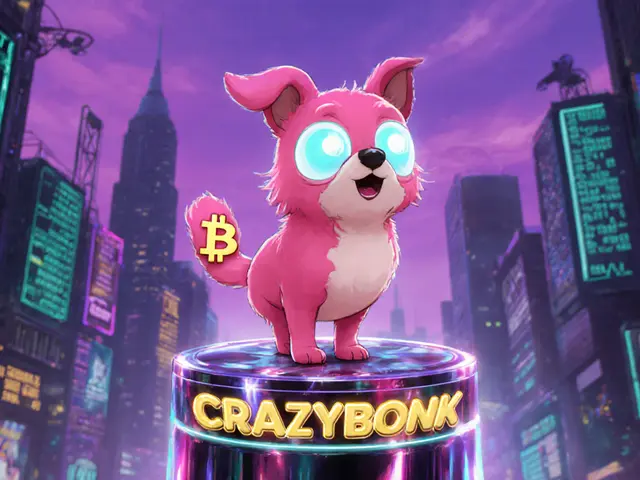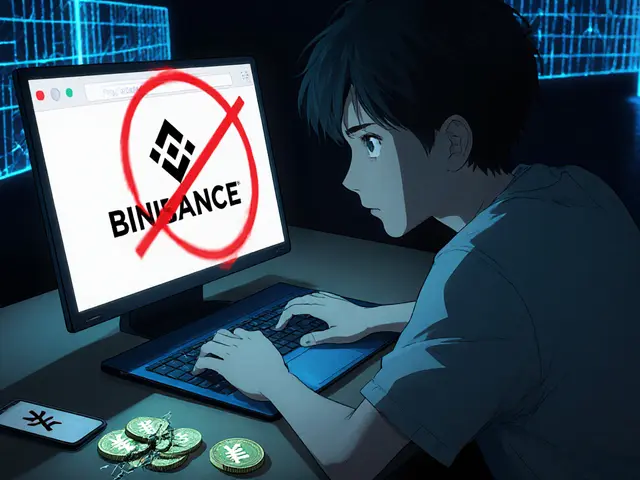BFX Platform Identifier
Use this tool to determine which BFX-related platform you're dealing with:
When you type BFX crypto exchange review into a search box, you’ll run into a mix of old and new projects that all use the BFX label. BFX is a tag that refers to a historic token issued by Bitfinex after its 2016 breach, as well as the branding of newer platforms such as BlockchainFX. Knowing which one you’re looking at is the first step before you trust any exchange with your money.
Quick Takeaways
- "BFX" can mean Bitfinex’s compensation token, the Bitfinex exchange itself, or the newer BlockchainFX project.
- Bitfinex survived a $72million hack, refunded all BFX tokens, and now keeps ~99.5% of assets in cold storage.
- BlockchainFX is still in presale, offers an all‑in‑one super‑app idea, but lacks audited code and a proven team.
- Security features to watch: multi‑sig cold wallets, two‑factor authentication, withdrawal whitelists.
- Do your own due‑diligence: check KYC policy, regulatory status, and whether the platform’s liquidity matches your trading style.
What Does "BFX" Actually Stand For?
The crypto world loves shortcuts, and BFX is a prime example. In August2016, Bitfinex suffered a massive breach that stole 120,000BTC (about $72million at the time). To make the loss manageable, the exchange issued a new token called the BFX token. Each token represented $1 of the user’s loss and could be traded, used as margin collateral, or redeemed for cash or equity.
Fast‑forward to 2025, the term BFX also appears in the branding of BlockchainFX, a fledgling project that markets itself as a "super app" for crypto trading, payments and more. It is completely separate from Bitfinex, has its own token (also called BFX), and is currently in a pre‑sale phase.
Bitfinex’s BFX Token - How the Compensation Worked
After the hack, Bitfinex reduced every user’s balance by 36% - regardless of the asset held - to create a pool of loss. The pool was then sliced into BFX tokens, each worth one US dollar. Users faced three choices:
- Redeem the tokens for cash or crypto immediately.
- Convert the tokens into shares of iFinex, Bitfinex’s parent company.
- Hold the tokens and hope for future recovery of the stolen funds.
Within eight months, Bitfinex had redeemed all BFX tokens and destroyed the remaining supply. Those who chose the equity route received Recovery Right Tokens (RRTs), which grant a claim on any future recovery of the stolen Bitcoin.
Bitfinex Today - Security Features You Should Know
Bitfinex has taken the hack as a hard lesson and upgraded its security stack. Key components include:
- Cold storage: About 99.5% of user funds sit offline in multi‑signature vaults, requiring multiple approvals to move.
- Multi‑signature wallets: At least three keys are needed for a withdrawal, reducing the chance of a single point of failure.
- Two‑factor authentication (2FA): Supported via Google Authenticator, Authy, or hardware U2F keys like YubiKey.
- Withdrawal whitelist: Users can lock withdrawals to pre‑approved addresses, blocking unknown destinations.
- Granular API permissions: Developers can limit API keys to read‑only, trade‑only, or withdrawal‑only scopes.
- Anti‑phishing code: Each user can set a unique code that appears on the login page, helping to spot fake sites.
Despite these measures, some regulators still keep a close eye on Bitfinex because of its complex corporate structure and past legal entanglements.

BlockchainFX - The New Kid on the Block
BlockchainFX (often shortened to BFX) pitches itself as an "all‑in‑one super app" that bundles spot trading, staking, fiat on‑ramps, and even non‑crypto services like bill payments. The project claims to have completed several third‑party audits and to follow a full KYC process.
However, the publicly available data is thin:
- No detailed whitepaper or audited smart‑contract code is posted on a reputable repository.
- The founding team remains largely anonymous; only a handful of LinkedIn profiles are linked to the venture.
- Token pricing is still in a presale stage, with a hard cap of 200million BFX tokens and a claimed use‑case for fee discounts.
- Liquidity is untested - the platform has not yet launched a live order book.
Investors should treat BlockchainFX as a high‑risk, high‑reward opportunity and verify any audit reports before committing funds.
BFX‑Related Platforms vs. The Big Players
| Platform | Founded | Spot Trading Fee (maker/taker) | Security Highlights | KYC / AML | Liquidity (24‑h volume, BTC) |
|---|---|---|---|---|---|
| Bitfinex | 2014 | 0.1% / 0.2% | 99.5% cold storage, multi‑sig, 2FA, withdrawal whitelist | Full KYC, supports corporate accounts | ~$9B |
| BlockchainFX | 2023 (presale) | 0.15% (planned) | Third‑party audit claims, 2FA, KYC on‑board | Standard KYC, no AML report yet | Not live (estimated < $100M) |
| Binance | 2017 | 0.0% / 0.1% | 99% cold storage, SAFU insurance fund, 2FA, device management | Tiered KYC, optional for low limits | ~$30B |
| Coinbase | 2012 | 0.5% (flat) | Cold vaults, insurance on custodial assets, 2FA, biometric login | Strict KYC / AML, regulated in US | ~$12B |
The table shows that while Bitfinex holds its own against the giants in terms of fee structure and security, BlockchainFX is still a newcomer with unproven liquidity. If you need deep order books and fast execution, the established exchanges win hands down.
Pros and Cons of Using a BFX‑Related Platform
- Pros
- Bitfinex offers a wide range of markets, including advanced margin and futures.
- Historical BFX token redemption demonstrated a unique compensation mechanism.
- BlockchainFX promises a unified app experience, potentially lowering the need for multiple accounts.
- Cons
- Bitfinex’s past hack still haunts its reputation; some regulators treat it with caution.
- BlockchainFX lacks audited smart‑contract code and a transparent team, raising red‑flag risk.
- Both platforms operate under ambiguous regulatory environments, which could affect fund access.
Red Flags & Due‑Diligence Checklist
Before moving any capital to a BFX‑labeled service, run through the following list:
- Identify which "BFX" you are dealing with - Bitfinex’s historic token, the Bitfinex exchange, or BlockchainFX.
- Check for third‑party security audits that are publicly accessible.
- Verify the team’s background - LinkedIn, prior projects, and legal entities.
- Confirm the exchange’s jurisdiction and regulatory licenses.
- Inspect withdrawal limits, whitelist options, and 2FA availability.
- Assess liquidity - look at 24‑hour volume and depth of order books.
- Read community feedback on Reddit, Twitter, and trusted review sites for recent incidents.
- Ensure you understand the tokenomics if you plan to hold BFX tokens (e.g., supply, vesting, redemption rights).
Frequently Asked Questions
What is the BFX token and can I still use it?
The original BFX token was minted by Bitfinex after the 2016 hack to reimburse users. All tokens were redeemed or destroyed by mid‑2017, so there are no active BFX tokens from that episode you can trade today.
Is BlockchainFX a safe place to store my crypto?
Safety depends on the audits and team transparency. As of October2025, BlockchainFX has not published verifiable smart‑contract audits or a full team roster, so the platform carries higher risk than established exchanges. Use only a small amount for testing until more evidence emerges.
How does Bitfinex’s security compare to Binance?
Both keep the vast majority of assets in cold storage and require multi‑factor authentication. Bitfinex emphasizes multi‑signature vaults and a withdrawal whitelist, while Binance adds a SAFU insurance fund and a broader device‑management system. In practice, Binance’s larger user base gives it deeper liquidity, but Bitfinex’s security controls are on par with industry standards.
Can I trade BFX tokens on other exchanges?
The historic Bitfinex BFX tokens are no longer listed anywhere. The newer BlockchainFX BFX token may appear on a handful of new DEX listings, but availability is limited and often tied to the presale phase.
What regulatory issues affect BFX‑related services?
Bitfinex has faced investigations in the US and Europe over alleged money‑laundering and corporate transparency. BlockchainFX, being a newer project, has not yet secured any explicit licensing, which could lead to restrictions in jurisdictions with strict crypto rules. Always check the local regulator’s stance before depositing large sums.
Bottom line: if you need a battle‑tested platform with deep liquidity, stick with the established Bitfinex exchange (or any of the major players). If you’re chasing the hype of a new BFX super‑app, treat it like any early‑stage startup - allocate only what you can afford to lose and verify every claim before signing up.












Katrinka Scribner
March 27, 2025 AT 08:59 AMWow, this BFX saga is a rollercoaster! 😅
Jacob Anderson
March 27, 2025 AT 10:20 AMOh great, another BFX rebrand – because what the crypto world really needs is more acronyms to confuse the already bewildered. The historic token was a neat little patch after a massive hack, and now a fresh “super‑app” pretends it’s reinventing the wheel. Sure, they’ll tout “third‑party audits” that no one can find, and a “team” that probably exists only in LinkedIn bios. If you enjoy paying for promises that smell like vapor, BlockchainFX might be your playground. Otherwise, stick with exchanges that have actually survived a few hacks without turning into a meme.
Billy Krzemien
March 27, 2025 AT 11:43 AMFirst off, kudos for digging into the BFX landscape – it can feel like wandering through a maze of tokens and names. The key is to split the three beasts: the legacy Bitfinex compensation token (now extinct), the Bitfinex exchange itself, and the emerging BlockchainFX project. For each, verify cold‑storage percentages, multi‑sig requirements, and whether a reputable audit report is publicly available. Also, compare KYC/AML policies – a solid exchange will be transparent about its licensing jurisdiction. Finally, test the waters with a tiny deposit before committing any serious capital.
april harper
March 27, 2025 AT 13:06 PMIn the grand theater of cryptocurrency, the name BFX has become a chimera, a spectral echo of loss and redemption that haunts both veterans and newcomers alike. One can imagine the original token as a phantom, a promise cast in digital ether to soothe the wounds inflicted by a $72 million theft, yet its very existence was a reminder that trust is a fragile glass. When Bitfinex emerged from the ashes, its cold‑storage vaults and multi‑signature guardians stood as sentinel knights, but the specter lingered, whispering doubts into the ears of regulators and skeptics. Then BlockchainFX entered, brandishing the banner of a “super‑app,” promising integration and convenience, but behind the glossy façade lay shadows – anonymous founders, unverified audits, and a liquidity pool that has never felt the pulse of a live order book. Each claim of security feels like a siren song, alluring yet potentially leading ships onto hidden reefs. The withdrawal whitelist, while a useful tool, is only as strong as the user’s discipline to enable it, and 2FA, though essential, cannot shield against social engineering attacks. Moreover, the regulatory environment wraps around these platforms like a tightening noose, reminding us that jurisdictional compliance is not merely a checkbox but a living contract with law. As we navigate these waters, we must remember that history repeats itself: the very mechanisms introduced to protect assets can become the very vectors exploited by adversaries. The lesson, perhaps, is not to place all faith in a single entity, however fortified, but to diversify, to spread risk like seeds across fertile fields. In practical terms, this means keeping the bulk of one’s holdings in cold storage, using exchanges only for liquidity, and constantly revisiting the security posture as updates roll out. It also implies demanding transparent audit reports, scrutinizing team credentials, and refusing to accept “claims” without evidence. Finally, it is a call to the community to hold these platforms accountable, to ask the hard questions, and to celebrate the successes while never forgetting the wounds that gave birth to BFX in the first place. Remember that security is a process, not a product, and the vigilance of the user is the final line of defense. By staying informed and skeptical, we can turn the BFX saga from a cautionary tale into a roadmap for safer crypto journeys. Only then can the community truly transform fear into confidence.
Clint Barnett
March 27, 2025 AT 14:30 PMWhen you peel back the layers of the BFX narrative, what emerges is less a binary choice between “good” and “bad” and more a spectrum of risk profiles painted in vivid hues. The Bitfinex exchange, with its 99.5 % cold‑storage claim, resembles a fortified castle, yet its history of legal entanglements reminds us that even the sturdiest walls can conceal hidden chambers. BlockchainFX, on the other hand, dazzles with the promise of an all‑in‑one super‑app, a one‑stop shop that many users find alluring, but the lack of a public audit is akin to a magician performing without showing the trick. From a fee perspective, Bitfinex offers a modest 0.1 %/0.2 % maker‑taker split, while the planned 0.15 % on BlockchainFX could be competitive if liquidity ever matures. Liquidity itself is the lifeblood of any exchange; without deep order books, slippage can erode even the lowest fees in milliseconds. Security features such as multi‑sig vaults, withdrawal whitelists, and hardware‑based 2FA form a layered defense, but they require diligent configuration by the user. In the end, the decision hinges on your tolerance for speculative exposure versus the desire for a seamless, integrated experience. Choose wisely, and remember that the crypto jungle rewards the vigilant more than the complacent.
Carl Robertson
March 27, 2025 AT 15:53 PMHonestly, the whole “vivid hues” metaphor feels like a cheap attempt to romanticize a market that still leaves investors exposed to rug pulls and regulatory crackdowns. While you praise the fee structure, you gloss over the fact that both platforms operate under ambiguous legal frameworks, which could abruptly freeze assets tomorrow. The “layered defense” narrative ignores user error, the most common vector for loss – think phishing, recycled passwords, and misconfigured whitelists. So before you hand out praise, maybe acknowledge that the safety of any exchange is ultimately tethered to the vigilance of its users, not just the checklist you’ve compiled.
Rajini N
March 27, 2025 AT 17:16 PMFor anyone considering moving funds to a BFX‑related platform, start by checking the official website for a publicly uploaded audit report, preferably signed by a known security firm. Verify the exchange’s jurisdiction and confirm whether it holds a license from a reputable regulator such as the FCA or the SEC. Enable hardware‑based 2FA, set up a withdrawal whitelist, and keep the bulk of your holdings in a personal hardware wallet. Test the platform with a small amount to gauge order‑book depth and withdrawal speed before scaling up. Finally, keep an eye on community forums for any reports of downtime or suspicious activity.
Kate Roberge
March 27, 2025 AT 18:40 PMWhile that checklist is solid, let’s not forget that “officially uploaded” audits can be fabricated, and a license from a lax regulator doesn’t guarantee safety. The real risk often hides in the fine print of user agreements, where clauses may allow the platform to freeze or seize assets under vague “compliance” reasons. So take those steps, but also maintain an exit strategy and keep a contingency stash off‑platform.
Oreoluwa Towoju
March 27, 2025 AT 20:03 PMLiquidity matters more than fancy security buzzwords.
Jason Brittin
March 27, 2025 AT 21:26 PM😂 Sure, if you’re happy with thin order books that can’t fill a 0.01 BTC trade, then security features are just window dressing. In reality, you need both depth and protection, otherwise you’re just gambling with your crypto.
Amie Wilensky
March 27, 2025 AT 22:50 PMIndeed-security, liquidity, and regulatory compliance form the triumvirate of considerations; each must be evaluated independently, yet they are inextricably linked, creating a complex matrix of risk. When an exchange touts “99.5 % cold storage,” the figure alone does not disclose the frequency of audits, nor the governance of multi‑signature policies; thus, a skeptical lens is warranted. Moreover, the presence-or absence-of a transparent team can dramatically affect user confidence, especially in presale projects like BlockchainFX, where anonymity often masks accountability. Consequently, a diligent investor should cross‑reference official documentation, third‑party audit reports, and community sentiment before allocating capital. Ultimately, the decision rests on a balance between potential reward and the tolerance for uncertainty.
MD Razu
March 28, 2025 AT 00:13 AMWhile your matrix analogy captures the theoretical underpinnings, in practice the crypto ecosystem rarely offers such tidy compartments; the reality is a chaotic jumble where security breaches, regulatory clampdowns, and market volatility intersect in unpredictable ways. Assertions about “99.5 % cold storage” often omit the nuance that even a single hot‑wallet compromise can trigger cascading withdrawals if internal controls are lax. Likewise, the allure of a “super‑app” hinges on user adoption, which cannot be forced by hype alone-organic growth demands proven infrastructure and transparent governance. Audits, when they exist, must be scrutinized for scope, methodology, and the credentials of the auditing firm; a superficial seal of approval is meaningless without rigorous peer review. Furthermore, jurisdictional licensing is a moving target, as regulators continuously update frameworks, leaving projects in a perpetual state of compliance limbo. Therefore, the prudent path is to diversify exposure across multiple vetted platforms, maintain personal custody of the majority of assets, and stay vigilant to emerging red‑flags in both code and corporate behavior. Only through such a disciplined, multi‑layered strategy can one hope to mitigate the inherent risks that accompany the promise of rapid innovation in this space.